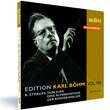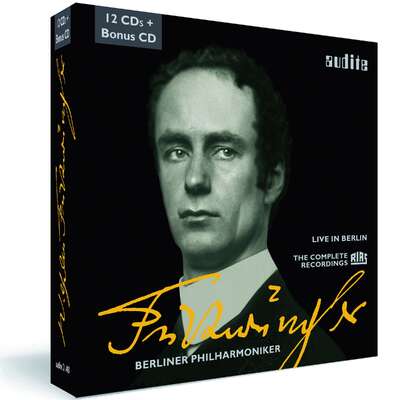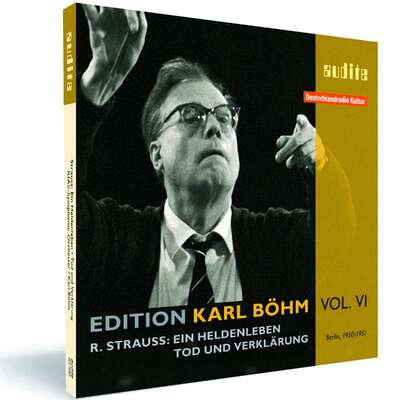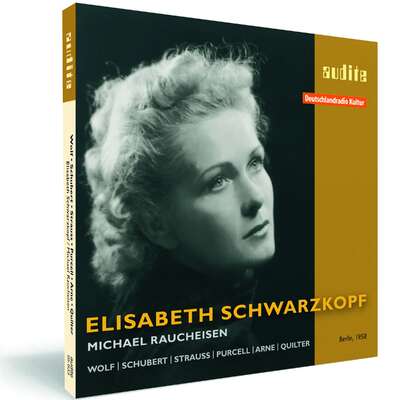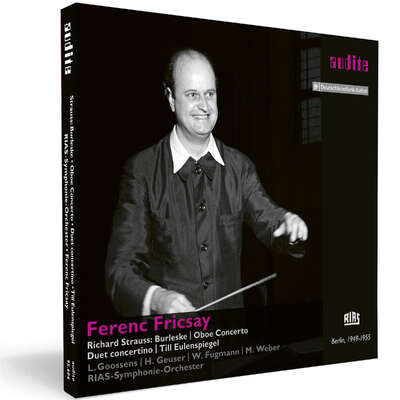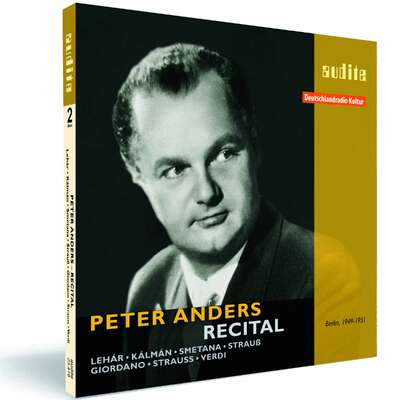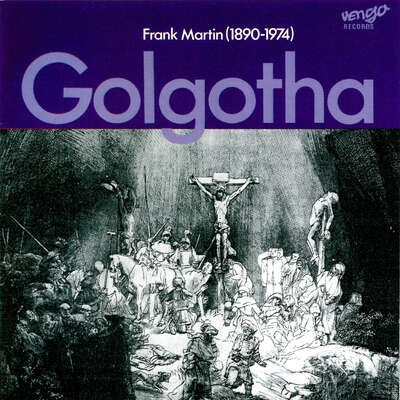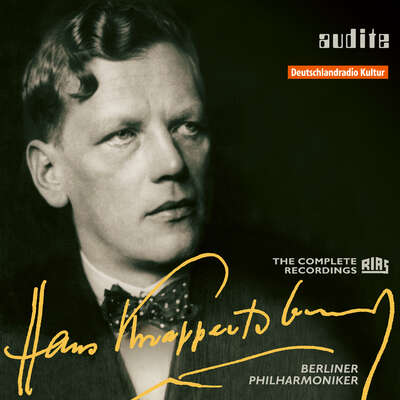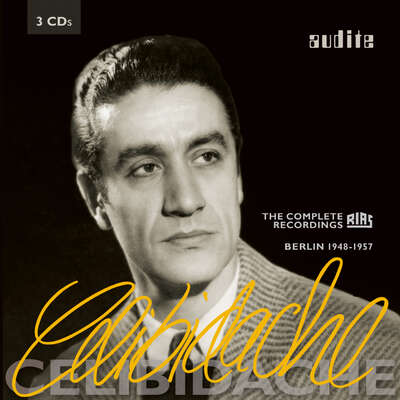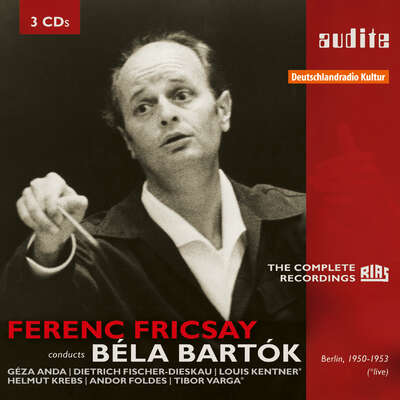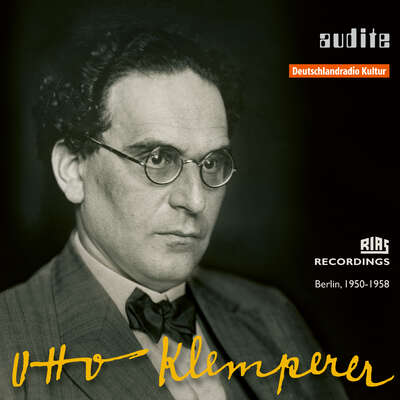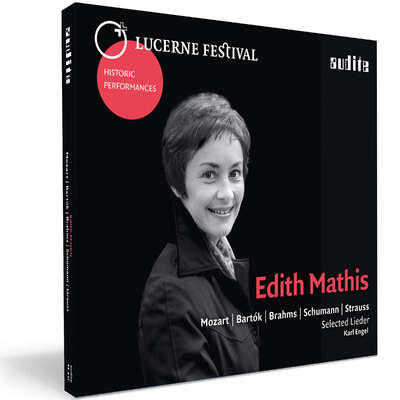
Karl Böhm and Richard Strauss were close to one another both on an artistic and a personal level. That is why Böhm’s Strauss interpretations are deemed to be “authentic”. These recordings of “Don Juan”, the “Alpine Symphony” and the suite of waltzes from “Der Rosenkavalier” were made only a few years after the death of the composer. They eloquently document how conscientiously Karl Böhm treated Richard Strauss’ legacy.more
Karl Böhm and Richard Strauss were close to one another both on an artistic and a personal level. That is why Böhm’s Strauss interpretations are deemed to be “authentic”. These recordings of “Don Juan”, the “Alpine Symphony” and the suite of waltzes from “Der Rosenkavalier” were made only a few years after the death of the composer. They eloquently document how conscientiously Karl Böhm treated Richard Strauss’ legacy.
Details
| Richard Strauss: Don Juan, Eine Alpensinfonie & Walzerfolge from Der Rosenkavalier | |
| article number: | 95.611 |
|---|---|
| EAN barcode: | 4022143956118 |
| price group: | BCB |
| release date: | 1. January 2010 |
| total time: | 79 min. |
Informationen
Karl Böhm and Richard Strauss: A congenial artistic friendship
“Meeting this ingenious man was of the highest significance to me”, Böhm writes in his autobiography. He was referring to Richard Strauss. During the 1930s, a relationship developed between the two artists which far exceeded a purely artistic partnership. Strauss’ particular esteem of Böhm culminated in his “artistic testament” which Strauss sent to Böhm in 1945 and in which he, amongst other things, specified his thoughts on the future of opera. The music of Richard Strauss was to remain a focal point in the repertoire of Karl Böhm. As he worked on many scores together with the composer, his Strauss interpretations can be called “authentic” – such as these recordings, officially issued on CD for the first time, of “Don Juan”, the “Alpine Symphony” and the famous suite of waltzes from “Der Rosenkavalier”. These recordings were made between 1952 and 1954 with the RIAS Symphony Orchestra, only a few years after the death of the composer. Böhm’s Strauss interpretations convince due to their clarity and the consistency of the overall conception. Lines and contours are marked out clearly. Böhm succeeds in organising the complex sound and maintains the proportions of the Strauss scores in an authoritative manner.
The production is part of our series „Legendary Recordings“ and bears the quality feature „1st Master Release“. This term stands for the excellent quality of archival productions at audite. For all historical publications at audite are based, without exception, on the original tapes from broadcasting archives. In general these are the original analogue tapes, which attain an astonishingly high quality, even measured by today‘s standards, with their tape speed of up to 76 cm/sec. The remastering – professionally competent and sensitively applied – also uncovers previously hidden details of the interpretations. Thus, a sound of superior quality results. CD publications based on private recordings from broadcasts or old shellac records cannot be compared with these.
Reviews
www.allmusic.com | 01.06.2011 | James Leonard | June 1, 2011 Richard Strauss: Don Juan; Eine Alpensinfonie; Der Rosenkavalier
Though none of these are among Karl Böhm's greatest performances ofMehr lesen
Crescendo Magazine | mise à jour le 18 novembre 2010 | Bernard Postiau | November 18, 2010
Bien que de 30 ans son cadet, Karl Böhm compta, à partir de 1934, auMehr lesen
www.ResMusica.com | 4 novembre 2010 | Patrick Georges Montaigu | November 4, 2010 Böhm dirige Strauss
Karl Böhm et Richard Strauss ont été non seulement contemporains maisMehr lesen
Fanfare | Issue 34:2 (Nov/Dec 2010) | Arthur Lintgen | November 1, 2010
Karl Böhm’s interpretations of Richard Strauss’s music tend to be fast (compared to modern practice) and more in line with the composer’sMehr lesen
Böhm also realizes that An Alpine Symphony will not tolerate forcing or rushing the tempos without destroying the mood of the piece or degenerating into empty bombast. He has a clear grasp of the work’s arch-like structure. Böhm unfailingly emphasizes clarity of instrumental textures without sacrificing dramatic impact. As the orchestra musically ambles “Along the Stream,” “On the Mountain Pasture,” and “Through the Thickets and Brushwood,” Böhm has a remarkable sense of how to move things along with subtle and constantly changing tempos that sustain musical interest where others merely plod their way to the summit. When the climax finally arrives “At the Summit,” Böhm delivers the goods with a broad and relaxed tempo. The “Thunderstorm” is graphically cinematic, dramatically effective, and entirely musical. “Sunset” and the “Epilog” are ideally judged as Böhm revels in Strauss’s lush string and brass sonorities.
Böhm’s interpretation would undoubtedly be even more stunning in modern stereo sound. This early 1950s recording (made just before the stereo era) is actually pretty good in terms of high-frequency presence and instrumental detail. This is not unlistenable historic sound, but there are major problems, especially for an orchestral showpiece like An Alpine Symphony. The upper registers of the organ are OK, but deep bass (organ pedal) is missing in action. The trumpets sound so strident and shrill that they seriously detract from the effect of the performance, especially at high listening levels. The recording also lacks the rich and warm low midrange (low strings) that is critical to Strauss’s lush orchestral sound.
Böhm’s An Alpine Symphony and Don Juan are required listening for serious Straussians, but they will also need to have alternative versions in modern sound. Zubin Mehta (Decca/London) and Mariss Jansons (RCO Live SACD) lead the field sonically in An Alpine Symphony, and there are numerous Don Juans with good sound out there conducted by the usual suspects.
klassik.com | August 2010 | Dr. Kevin Clarke | August 30, 2010 | source: http://magazin.k... Zum Gipfel mit der Försterchristl
Keine Frage: Karl Böhm (1894-1981) war ein bedeutender Strauss-DirigentMehr lesen
Audiophile Audition | July 14, 2010 | Gary Lemco | July 14, 2010
Edition Karl Bohm VIII
Classic, “definitive” Richard Strauss from his most devoted acolyte, Karl Bohm
“I promised the master to look after this legacy faithfully for as longMehr lesen
International Record Review | July/August 2010 | July 1, 2010
Audite continues its survey of Karl Böhm's RIAS Berlin recordings from the early 1950s with a Strauss disc which includes Don Juan, the AlpineMehr lesen
Infodad.com | 10.06.2010 | June 10, 2010
Each of these CDs is not only fine on its own level but also part of aMehr lesen
Diapason | N° 581 juin 2010 | Rémy Louis | June 1, 2010
Plusieurs parutions (Audite, Hänssler...) ont permis récemment de saluer Karl Böhm interprète straussien. Cœur de ce CD inédit – Don JuanMehr lesen
Les valses du Chevalier à la rosé révèlent ensuite une perception très sûre du contexte dramaturgique de l'opéra. L'accentuation savante et la décontraction du ton sont réjouissantes, à mi-chemin entre Vienne et Munich – et quelle transparence, là encore! Mise au service d'un univers tout autre, elle illumine également un Opus 58 de Beethoven d'un son glorieux (plus que l'édition Tahra), pour les mêmes raisons que ci-dessus. On a l'impression d'assister à ce concert donné en 1950 au Titania-Palast. Onze ans après la singulière gravure avec Gieseking (et Dresde, Emi, 1939), Böhm converse cette fois avec Wilhelm Backhaus. Passion de la clarté, exigence de l'articulation, ferveur rhétorique, flamme intérieure: le maître allemand sculpte le détail au sein du grand geste – la cadence de l'Allegro est extraordinaire, le finale irrésistible. Influence de l'air berlinois ? Dans l’Andante con moto, le legato de Böhm a des tentations furtwänglériennes, plus que dans aucune autre de ses versions (avec Backhaus encore, puis Pollini).
Enregistrée en studio, claire de lignes et assez sombre de propos, la Symphonie n° 4 (inédite, 1952) est intrigante dans son ambiguïté même. Aucun autre de ses témoignages ne donne à l’Adagio introductif une telle densité attentiste, comme une anticipation du début de l'acte II de Fidelio. Un choix volontaire, car l'émotion qui sourd de l’Adagio central participe encore d'une autre nuance expressive, plus lyrique, mélancolique aussi. Etrangers aux imprécations d'un Scherchen (Tahra) comme aux ivresses de Carlos Kleiber (Orfeo), les tempos de Böhm paraîtront sans nul doute modérés pour nos habitudes actuelles (il est vrai que certains sforzatos manquent parfois de tension). Mais, comme souvent, l’élan intérieur et l’animation incoercible du discour demeurent.
Der neue Merker | Mittwoch, 19. Mai 2010 | Dorothea Zweipfennig | May 19, 2010
Karl Böhms spritzige „Rosenkavalier“-Walzerfolge und der forschMehr lesen
Diverdi Magazin | 192 / mayo 2010 | Miguel Ángel González Barrio | May 1, 2010
Mal de altura
Dos grandes versiones de la Sinfonía Alpina – una moderna, firmada por Philippe Jordán, otra histórica, con Karl Böhm en el podio – dan fe del creciente interés por esta obra maestra de Richard Strauss
Decididamente, el alpinismo está de moda. La mastodónrica (1) Eine Alpensinfonie, op. 64 de Richard Strauss, presencia extraña en las salas deMehr lesen
El joven (n. 1974) director suizo, hijo de Armin Jordán (1932-2006), parece haber escogido la Sinfonía alpina como tarjeta de presentación. Con ella deslumhró en San Francisco, en octubre de 2007. La dirigió con gran éxito en Berlín, en septiembre pasado, en el concierto inaugural de la temporada sinfónica de la Staatskapelle de Barenboim. Elegida como metáfora de los retos que le esperan en su nuevo puesto, la dirigió también en su personal toma de la Bastilla, el 14 de noviembre último, en el concierto que marcó su debut al frente de la Opera Nacional y que acaba de publicar Naïve. Un suculento aperitivo antes de abordar El anillo del nibelunao, su primer proyecto operístico conjunto (El oro del Rin se estrenó en marzo). En Berlín y París la emparejó con el Concierto para violíny orquesta de cámara de György Ligeti (obra no incluida en el disco). Dos visiones contrastantes del virtuosismo. La prestación de la Orquesta de la Opera para el suizo dejó en evidencia que, hoy por hoy, es la más en forma de las orquestas parisinas: cuerda sedosa, homogénea, perfectamente empastada, soberbias maderas y metal preciso; entrega total y gran empatia con su nuevo titular. Llaman la atención en esta versión el pasmoso control (Eintritt in den Wald, preparación de la tormenta en Stille vor dem Sturm) de la batuta, el sonido limpio, adelgazado (¡la orquesta parece formada por la mitad de músicos!), la transparencia (Erscheinung, Auf dem Gipfel, Gewitter und Sturm), la capacidad para la recreación y diferenciación de timbres y colores orquestales (sonoridades cristalinas en Am Wasserfall, delicadas sfumature en Nebel steigen auf). Jordán hace suya la célebre recomendación de Strauss de dirigir su música como si se tratase de Mozart o Mendelssohn. Ciertamente, Jordán no se pierde en la espesura, no se recrea hedonísticamente en sensuales y opulentas oleadas de sonido. Sus ff y fff nunca devienen en atronadoras y confusas descargas decibélicas: parece no perder de vista las palabras de La Roche en Capriccio, reproducidas como lema en la primera página de la partitura: "Sed considerados con los cantantes. La orquesta, no demasiado alta". Con todo, sus climax no resultan nunca tímidos. Escuchando esta Alpina me vienen a la memoria las palabras de Nietzsche en Ecce homo: "El hielo está cerca, la soledad es inmensa, ¡mas qué tranquilas yacen todas las cosas en la luz! [...] ¡cuántas cosas sentimos debajo de nos otros!". Un Nietzsche en el que lo apolíneo domina sobre lo dionisíaco; en el que el "aire de las alturas" es puro, mas quizá no tan fuerte como en otras cumbres. La interpretación gana en intensidad y desenvoltura a medida que avanza: si el ascenso peca a veces de cauteloso, calculado, una vez en la cima Jordán se muestra seguro. Los dos números finales llevan la firma de un maestro (¿ "Le merveilleux Jordán"?). Con parsimonia, desgrana las emotivas frases en los violines del Strauss más inspirado, degustándolas, gustándose (Ausklang). La luz se desvanece lentamente para dar paso a la noche, en un beatífico, bellísimo final cíclico.
No cabe duda de que Jordán ama y conoce sobradamente la obra. Le falta, quizá, el último grado de perfección, de conocimiento, el de quien ha convivido largo tiempo con ella y transita los majestuosos y familiares paisajes con juveniles entusiasmo y decisión, diríamos irreflexivamente, sin necesidad de consultar el mapa. Es el caso de Karl Böhm, straussiano emérito, amigo del compositor, director de los estrenos de La mujer silenciosa y Daphne, dedicatario de esta última. Audite publica, por primera vez a partir de los másters de la Radio de Berlín, un nuevo disco Strauss del director de Graz con la Orquesta de la RIAS, con idéntico programa al del primer compacto del triple álbum DG con las superiores Staatskapelle Dresden y Filarmónica de Berlín. El disco DG se beneficia asimismo de un mejor sonido (2). Con una orquesta menos disciplinada que la francesa (hay aquí pasajes chapuceros, como las figuraciones de los violines en Erscheinuna), la excursión de Böhm es más excitante. En los climax libera una energía descomunal. Es potente antes que majestuoso (Auf dem Gipfel), insinuante, sensual (Elegie), más directamente realista que evocador (Gewitter und Sturm). Orquesta y toma de sonido (monoaural de 1952, y no muy conseguido) no dan para refinamientos y transparencias. Sin embargo, hay en la interpretación de Böhm, más generoso (extremo incluso) con las dinámicas que el suizo, una espontaneidad y una familiaridad incontestables. Completan el disco un arrollador Donjuán de singular atractivo, con una rudeza y una energía primaria arrebatadoras y una Suite de valses de El caballero de la rosa (tercer acto) de acusado sabor popular, algo gamberro (Ochs), teñida de nostalgia por un pasado perdido. Exagerado, cómico, marcando mucho los tiempos fuertes, Böhm se divierte (se le oye cantar en un momento de la grabación) y nos entusiasma.
NOTAS___________________________
(1) Escrita para una orquesta de unos 150 ejecutantes (¡con 20 trompas!), si incluimos trompas, trompetas y trombones que tocan fuera de escena.
(2) Las tomas de 1957 de Donjuán y la Sinfonía alpina son monoaurales, aunque DG las publicó en falso estéreo.
Pizzicato | N° 202 - 04/2010 | Alain Steffen | April 1, 2010 Böhms dynamischer Strauss
Mit der Entwicklung der Stereophonie und der neuen technischen Möglichkeiten der Schallplatte hat auch in Sachen Interpretation eine neue ÄraMehr lesen
Was man auch den Orchesterwerken alles herausholen kann, das haben uns Thielemann, Maazel und Rattle in den letzten Jahren auf CD bewiesen. Verglichen mit diesen Hochglanzproduktionen überraschen Karl Böhms Einspielungen aus den frühen Fünfzigerjahren in mehreren Hinsichten.
Böhm zeigt uns, wie interpretatorisch vielseitig und tiefgründig die Musik von Strauss sein kann. Und mit welcher Frische sie gespielt werden kann! Ohne den einlullenden Supersound konzentrierte man sich damals noch auf das Wesentliche und das Resultat ist – wie uns diese Einspielung zeigt – musikalisch weitaus überzeugender als so manche Neueinspielung. Böhm konzentriert sich in den drei Werken auf die musikalische Linie, lässt das Orchester atmen und animiert seine Musiker, die Musik von Strauss genauso filigran, beschwingt und fließend wie die Musik Mozarts zu spielen. So erleben wir einen wunderbaren 'Don Juan', der hier eine ungewöhnliche Charakterisierung erhält und als eine vielschichtige Figur vorgestellt wird. Auch bei der 'Alpensymphonie' geht es Böhm nicht um einen stimmungsvollen Panoramablick im Postkartenformat, sondern um das Hörbarmachen einer genialen Partitur, die auch ohne das Zutun klanglicher Kunstgriffe zu überzeugen weiß. Und die Walzerfolge aus dem 'Rosenkavalier' als Abschluss ist unter Böhms Leitung ein Funken sprühendes Feuerwerk. Wenn das RIAS-Symphonie-Orchester auch manchmal an seine damaligen spielerischen Grenzen stößt, so ist diese Audite-Veröffentlichung eines der wertvollsten Strauss-Dokumente, die ich kenne.
Wochen-Kurier | 24. März 2010 Nr. 12 | Michael Karrass | March 24, 2010
„Die Begegnung mit diesem genialen Menschen war für mich von höchsterMehr lesen
www.classicstodayfrance.com | Février 2010 | Christophe Huss | February 1, 2010
En découvrant cet enregistrement de radio inédit je me suis dit que,Mehr lesen
